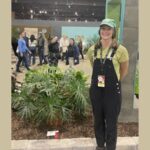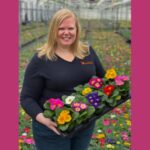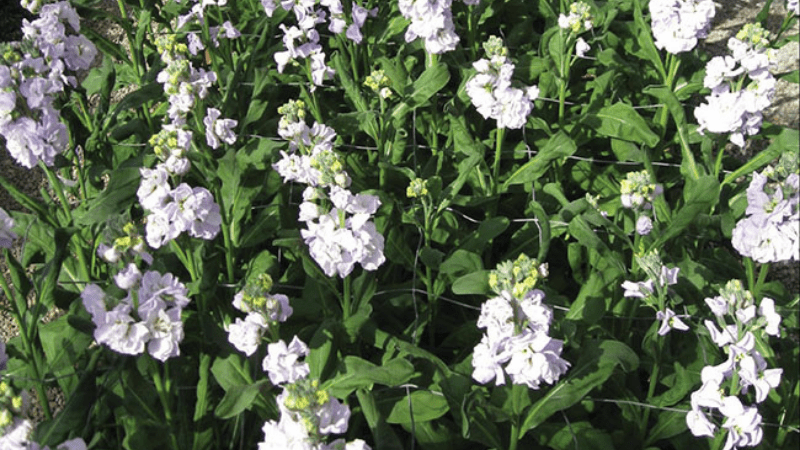
Photoperiod management
Due to consumer demand for local, unique, fresh and high-quality cut flowers, domestic production of specialty cut flowers continues to increase across the country. Those interested in growing specialty cuts are finding that the premium prices one can receive for stems and pre-arranged bouquets at farmers markets, u-pick and non-traditional florists, especially off season is quite lucrative.
However, there are several factors that influence the flowering responses of cut flowers and growers must consider how juvenility, photoperiod (day length), light quantity and temperature influence off-season and year- round production in greenhouses and high tunnels.
SPECIALTY CUT FLOWER RESEARCH
Over the past 10 years, our group has been conducting specialty cut flower research in the three production systems (field, high tunnels, and greenhouses) to:
- Determine the flower initiation and development requirements of challenging crops and new introductions and
- Compare production systems that results in high yields and stem quality in the mid-western U.S.
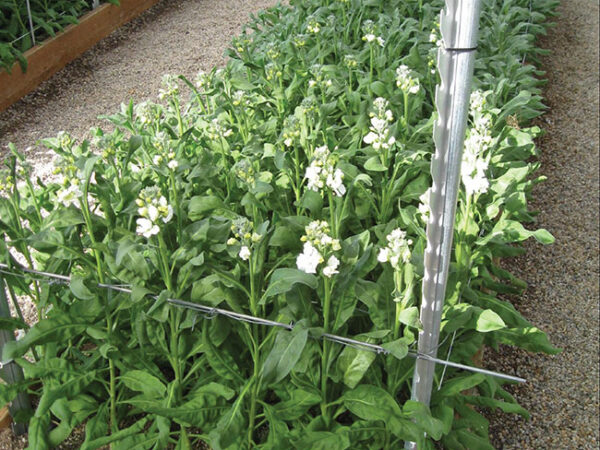
In this article, we will focus our attention on photoperiod and how it should be managed during the young plant (ie. seedlings or rooting of cuttings) and production stages for some of the most popular specialty cut flowers produced.
WHAT IS PHOTOPERIOD?
Photoperiod can influence many aspects of plant growth and development including dormancy, storage organ formation and, most importantly, flowering.
Many cut flowers, potted flowering, bedding plants and herbaceous perennials flower in response to day length. While we refer to photoperiod when discussing flowering responses, it is actually the uninterrupted period of darkness that controls plant responses to day length. The natural dark period, or skotoperiod, can be extended (to create a shorter day) or shortened by providing electric light (to create a longer day) to manage photoperiodic plant responses such as flowering. For most crops, a short day and long day are perceived when the night length is at least 12 hours and less than 10 hours, respectively.
PHOTOPERIODIC RESPONSE GROUPS
There are three main photoperiodic response groups: short-day plants (SDP), long-day plants (LDP) and day-neutral plants (DNP). SDPs flower when the daylength is at or shorter than a certain length specific to each plant genera. For example, dahlia is classified as SDP (Table 1). Whereas LDPs flower when the daylength is longer than a certain length.
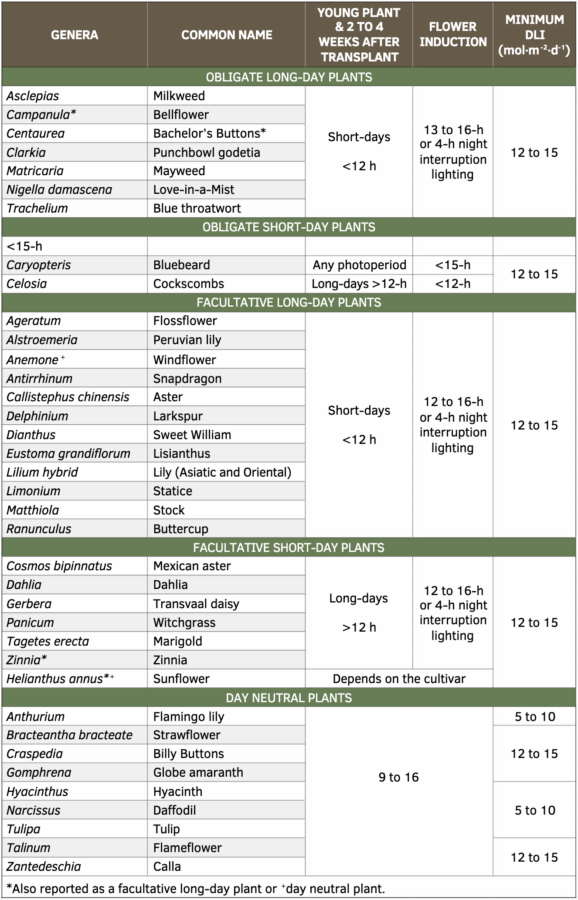
Day-neutral plants flower regardless of the daylength. Furthermore, the LDP and SDP responses may be classified as either obligate (qualitative) or facultative (quantitative). An obligate photoperiod response means that the plant must be exposed to SDs- or LDs to flower or it will remain vegetative.
Alternatively, a facultative LDP or SDP will flower more quickly when placed under LDs or SDs, respectively, though flowering will eventually occur regardless of daylength as is the case with stock (Figure 1). Photoperiodic response groups of many common specialty cut flowers are listed in Table 1.
CRITICAL DAYLENGTH
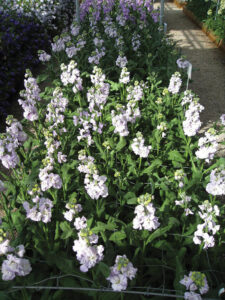
How do you know how “long” or “short” a day needs to be to induce flowering? Earlier we mentioned flowering when photoperiods are above or below specific lengths for LDP or SDPs, respectively. This specific daylength is often called the critical daylength (CDL) and is the photoperiod above- or below-which flowering occurs for LDP or SDP, respectively. For African marigold an facultative SDP, the CDL is around 12 hours and flowering occurs when the photoperiod is 12 hours or shorter.
CREATING ARTIFICIAL SHORT DAYS
A SD can be created in the greenhouse by using an opaque woven material such as black cloth or blackout cloth. Black cloth can be pulled manually or with an automatic curtain system over benches or an entire greenhouse section at a specified time each day to truncate the natural day length. The cloth is then retracted at a specified time in the morning to expose plants to light. Materials used for black cloth are generally synthetic black fabric with reflective outer surfaces or plastic. Black plastic is not widely used due to the lack of durability and potential for heat build-up and condensation, which can cause the plastic to collapse on top of the plants but may be useful when providing SDs to a small number of plants.
CREATING ARTIFICIAL LONG DAYS
Growers may use either day- extension (DE) or night interruption (NI) photoperiodic lighting to create LDs. Each method has advantages and disadvantages but generally, they are similarly effective. Both require the delivery of at least ~2 μmol·m−2·s−1 of light when measured at plant height.
DE lighting is the delivery of light to extend the length of the natural day. The duration of DE lighting will depend upon the period of darkness required and the natural day length. For instance, if the natural day length is 9.5 hours and a 13-hour photoperiod is desired, lighting should operate from dusk for ~3.5 hours.
NI lighting is the practice of providing low-intensity light to plants during the middle of the night. By interrupting the dark period, plants will perceive a “short” night (or “long” day). It is typically delivered for 4 hours from 10:00 p.m. to 2:00 a.m.
PHOTOPERIOD FOR YOUNG AND FINISH PLANT PRODUCTION
A common misconception is that you need to grow photoperiodic crops under inductive day lengths from the start. Given that stem length of cut flowers is one of the most important quality parameters when harvested, you do not want to provide an inductive day length to seedlings or rooted cuttings as they will prematurely flower. Premature flowering can result in shorter stem lengths than desired, small flowers, and greatly reduced yields.
Therefore, the opposite daylength that is required for flowering should be provided at the young plant stage. Let’s reference Table 1, we can
see that bellflower is classified as either an obligate or facultative LDP. Therefore, young plants should be propagated and grown a few weeks after transplant under SDs to bulk them up before flower induction under LDs. Thus, by properly managing the photoperiod during the off-season, you can achieve desired plant responses, such as bulking up the plant or accelerating flowering and reaching target market dates more reliably.
Acknowledgements: We thank the Association of Specialty Cut Flower Growers, Pan American Seed, and the American Floral Endowment for supporting our cut flower research.

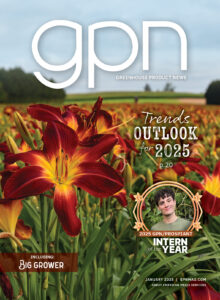
 Video Library
Video Library 













